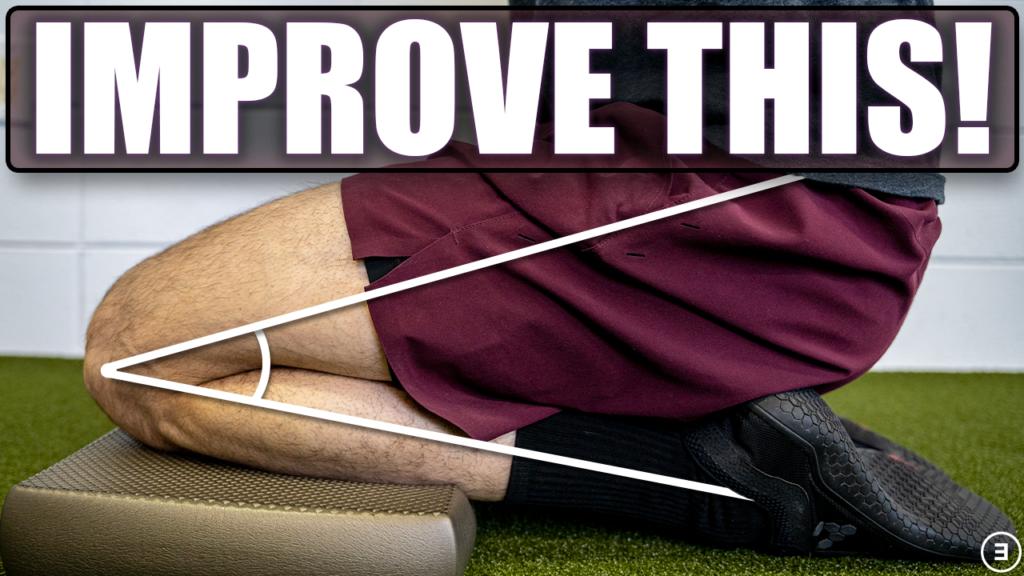The purpose of this blog is to discuss how to assess and improve knee flexion range of motion after an injury or surgery in a simple, safe, and efficient manner.
Looking to improve your strength, range of motion, and power to enhance your function and performance? Check out our Knee Resilience program!
Knee Flexion Range of Motion Self Assessment
There are 2 primary ways to assess your knee flexion range of motion:
Option 1. Lie on your back and pull your knee toward your butt as far as comfortable. Use your hands, towel or another object to provide overpressure, if needed.
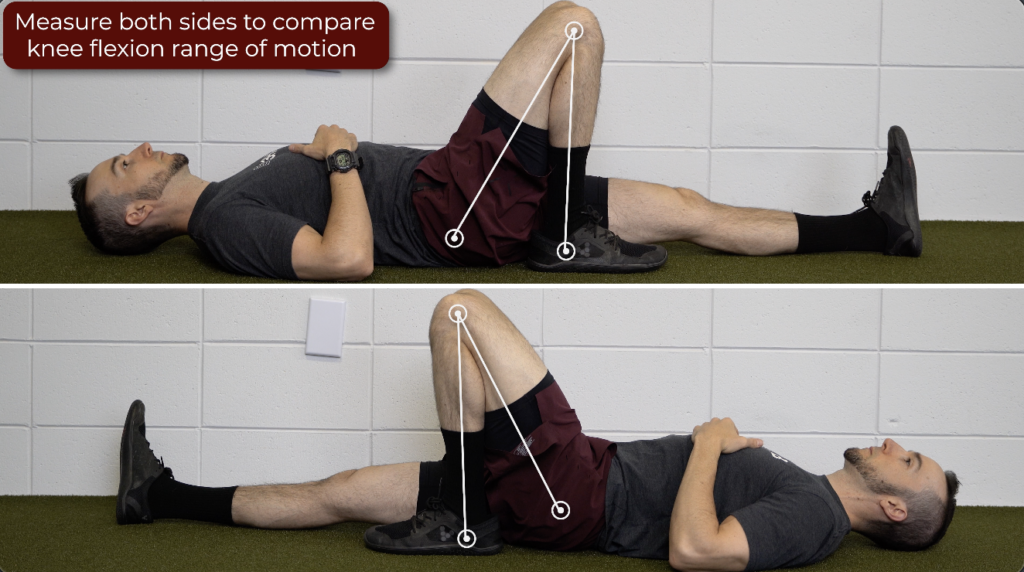
Option 2. Start on hands and knees and rock your butt back toward your heels.
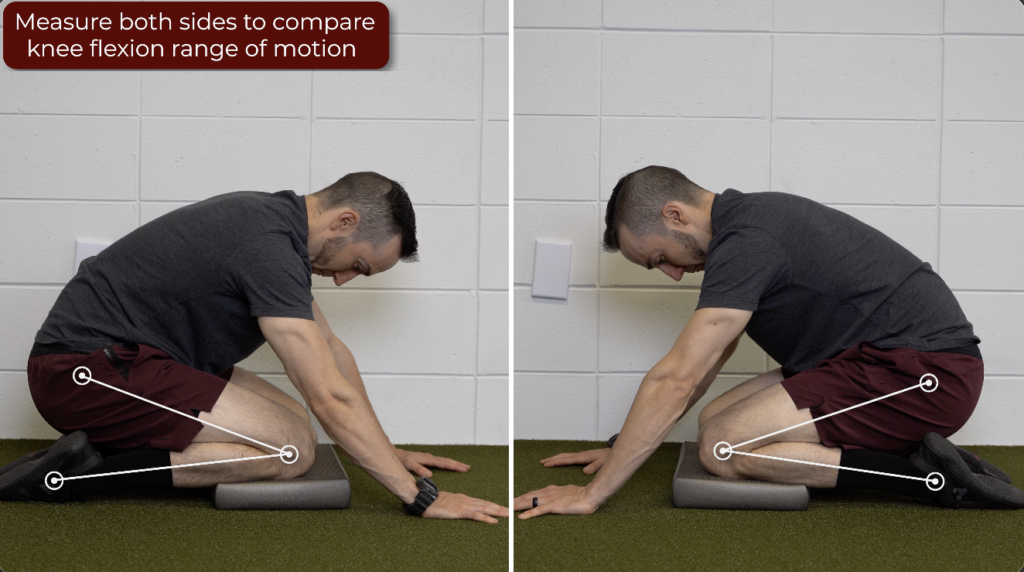
When looking from the side, measure how much your knee bends compared to the uninvolved side. An easy way to do this is looking at the distance from your heel to your butt.
How Much Knee Flexion Do You Need?
Normal knee flexion is being able to bring the heel to butt or very close to it. This is about 135°.
Following most surgeries, you should aim to restore full knee flexion range of motion, so the same amount as your uninvolved side.

For example, if you are recovering from ACL or meniscus surgery, regaining full knee flexion is a realistic goal. However, there are some surgeries, such as total knee replacement, where achieving full knee flexion may be more challenging.
Knee Flexion Range of Motion Exercises
An easy starting point for introducing knee flexion is using a stationary bike. Start with the seat at a higher level. At first, you may only do partial revolutions, moving the knee in and out of as much flexion as tolerable. As range of motion improves you can progress by completing full revolutions. And then finally, over time, slowly lower the seat down to expose the knee to more flexion. Do this for 5-10 minutes, 2-3 times a day, every day, or within tolerance.

If you do not have access to a bike, another starting option is heel slides. Using a slider on carpet or a towel or sock on hardwood, actively slide your heel toward your butt, bending the knee.
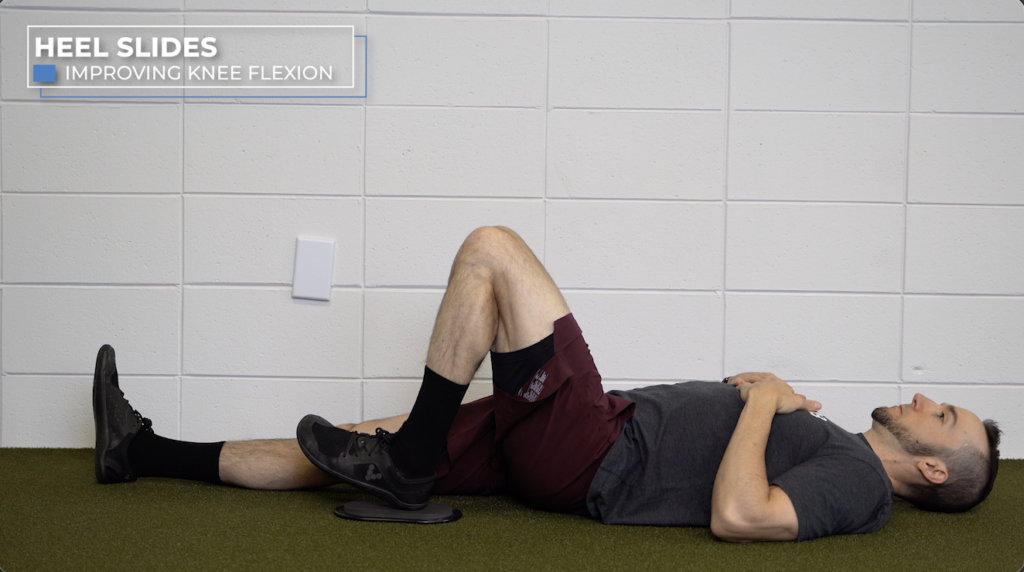
If your range of motion is improving and you need to progress, place a towel or strap around the ankle or foot to help pull the knee into more flexion. Do this for 10-15 repetitions, 2-3 times a day, every day, or within tolerance.

A slightly more advanced option is a kneeling progression. In addition to improving knee flexion, these can be helpful for desensitizing the knee to a kneeling position.
Start with quadruped rock backs, rocking your butt back to your heels as far as tolerable. Progress to a tall kneeling rock back, where you will transition from a tall kneeling position to a low kneeling position; and finally to a half kneeling rock back which will bias one knee. Start in a half kneeling position and sit your butt back to your heel as low as tolerable.

Two recommendations for making these more comfortable. First, place a pad or pillow under the knee. And second, a small towel behind the knee, may make the bottom position more tolerable and allow you to move into more flexion. For either of these, perform for 10-15 repetitions, 1-2 times a day, every day.
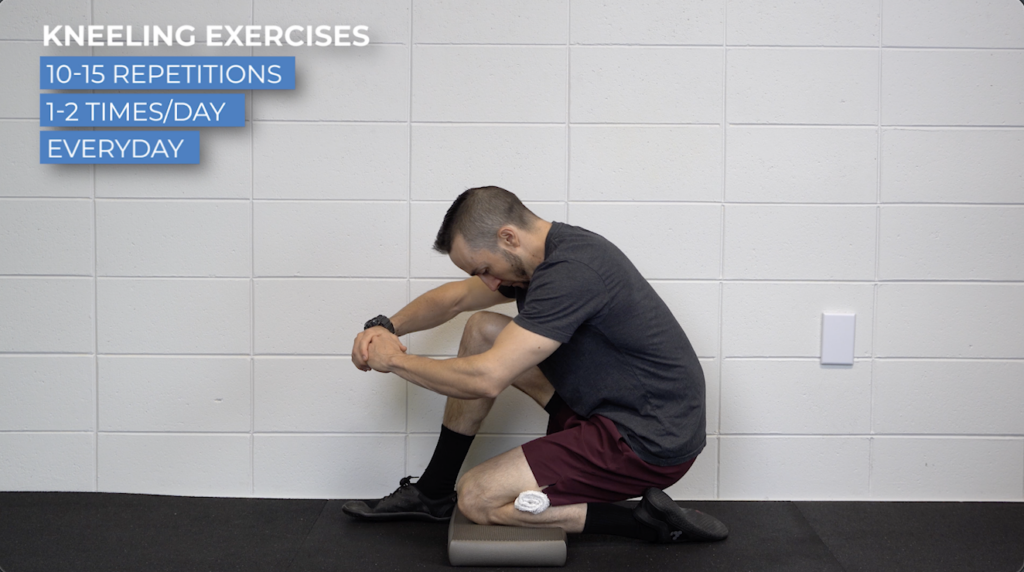
And finally, a more advanced option is a squat progression which will place more weight and load through the knee.
Start with an assisted squat using a TRX, squat rack or even a door frame. Squat as low as you can comfortably, bringing your butt towards your heels.
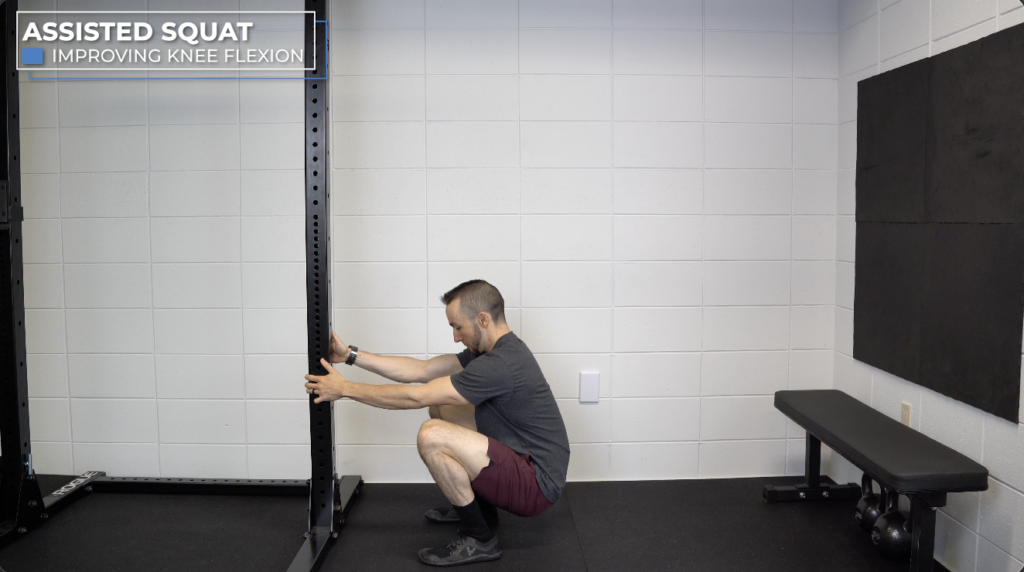
To progress, you can perform a heel elevated squat. Prop your heels on an elevated surface, and squat down, trying to move the knee into as much flexion as comfortable. For either of these, perform for 6-10 repetitions, as needed.
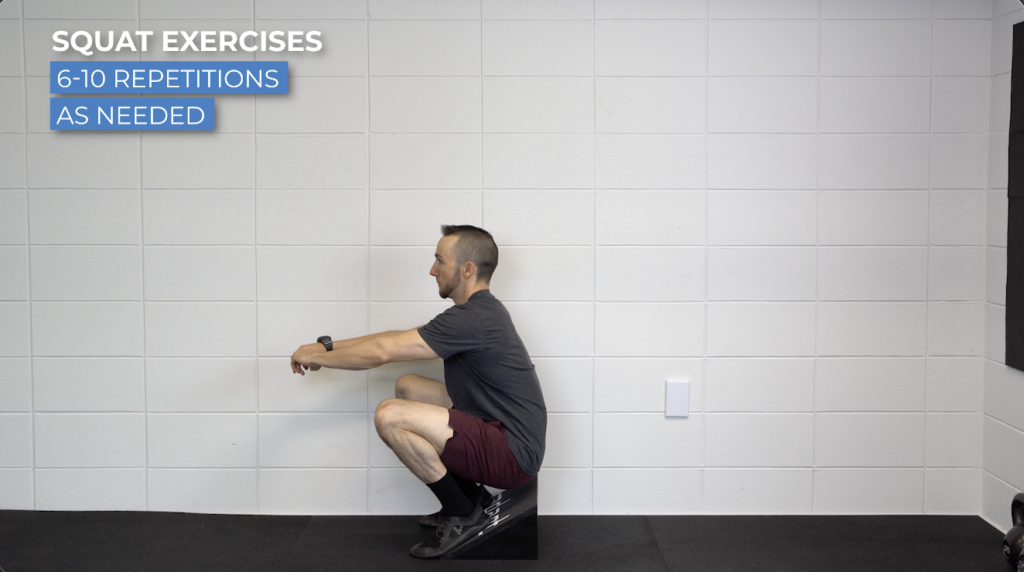
All of these options place an emphasis on improving knee flexion range of motion with the hip in flexion. Another consideration might be working on knee flexion with the hip in neutral or extension.
2 options. First, a dynamic couch stretch progression. While kneeling, elevate your back foot, squeeze your glutes and tuck your tailbone, and rock your butt back toward your heel. Slowly move in and out of this position. To progress, perform the same movement but lift your arms overhead. For these, perform for 10-15 repetitions, as needed.


And two, if you cannot tolerate kneeling, another option is the rear foot elevated split squat, with emphasis on knee flexion of the back leg. Elevate your back foot, and as you lower down, think about sitting your butt back toward your heel. Perform for 6-10 repetitions, as needed.
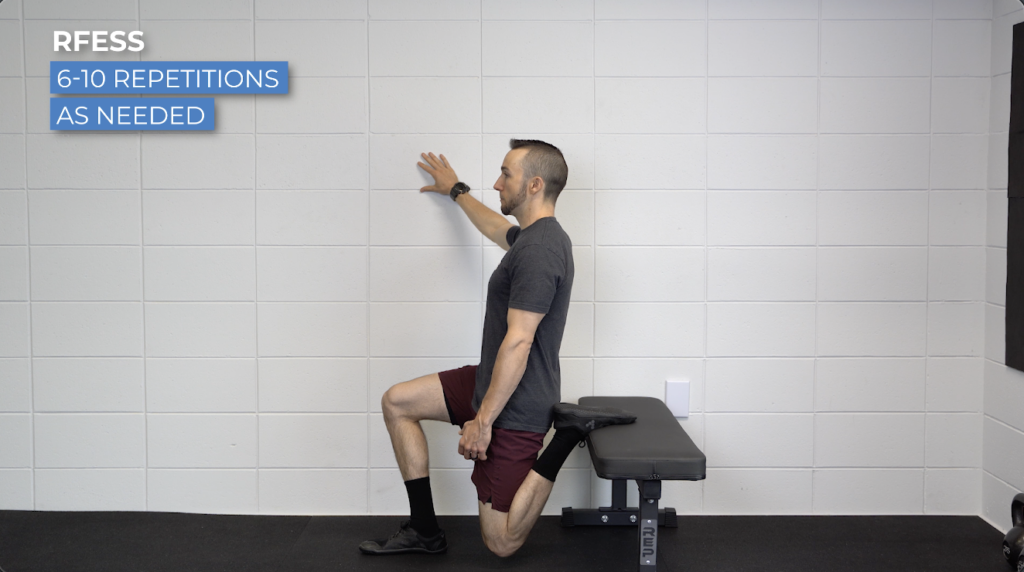
Exercise Recommendations
- Keep pain tolerable during exercise. While there might be some discomfort in the knee joint, it should not be the goal.
- Exercises should not lead to an increase in knee swelling or an exacerbation in symptoms.
- Progress as tolerated. Progress may vary based on surgery, precautions, previous range of motion, etc.
Knee Flexion Range of Motion Summary
In summary, it is recommended you aim to regain full knee flexion range of motion after an injury or surgery, if possible, by touching your heel to your butt or getting very close to it.
Early on, you can use a stationary bike for 5-10 minutes or perform heel slides for 10-15 repetitions. Do these often, so 2-3 times a day, everyday, or as tolerable.
As your range of motion improves, you may consider advanced options such as kneeling and or squatting progressions.
Another consideration is performing knee flexion exercises with the hip in an extended or neutral position, such as the dynamic couch stretch or rear foot elevated split squat with emphasis on the back leg.
And finally, more is not always better. Move within a comfortable range and progress as tolerated.

Disclaimer
The exercises presented in this blog are options that encompass a spectrum of knee issues that present along a variable timeframe. Exercise selection and timelines will differ based on the injury/surgery, symptoms, goals, etc.
For example, someone with a knee replacement may incorporate biking, heel slides, and squatting, but the kneeling progression and achieving 135 degrees of knee flexion may not be realistic or necessary.
On the other hand, someone who practices jiu-jitsu may want to eventually incorporate the kneeling progression and more advanced options as preparation for their sport.
As always, you should communicate any concerns with your surgeon, physical therapist, or other healthcare provider.
Don’t forget to check out our Knee Resilience Program!
Improving Knee Extension Range of Motion, ACL Rehab: Start to Finish, Meniscus Tears
Thanks for reading. Check out the video and please leave any questions or comments below.


